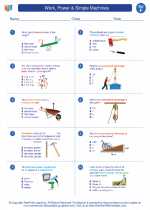What is Mechanical Energy?
Mechanical energy is the energy possessed by an object due to its motion or position. It is the sum of potential energy (energy due to position) and kinetic energy (energy due to motion).
Potential Energy
Potential energy is the energy stored in an object based on its position or state. There are different forms of potential energy, including gravitational potential energy and elastic potential energy.
Gravitational Potential Energy Formula:
PE = mgh
- PE = gravitational potential energy
- m = mass of the object
- g = acceleration due to gravity
- h = height of the object above a reference point
Elastic Potential Energy Formula:
PE = 0.5 * k * x^2
- PE = elastic potential energy
- k = spring constant
- x = displacement from the equilibrium position
Kinetic Energy
Kinetic energy is the energy an object possesses due to its motion. The kinetic energy of an object depends on its mass and velocity.
Kinetic Energy Formula:
KE = 0.5 * m * v^2
- KE = kinetic energy
- m = mass of the object
- v = velocity of the object
Conservation of Mechanical Energy
According to the law of conservation of energy, mechanical energy is conserved in the absence of non-conservative forces, such as friction or air resistance. This means that the total mechanical energy of a system remains constant over time, as it can only be transferred between potential and kinetic forms, but cannot be created or destroyed.
Real-life Examples
- A pendulum swinging back and forth demonstrates the interconversion between potential and kinetic energy.
- A roller coaster at the top of a hill has maximum potential energy, which is converted to kinetic energy as it moves downhill.
Conclusion
Mechanical energy plays a crucial role in understanding the behavior of objects in motion and is governed by the principles of potential and kinetic energy. Understanding these concepts can help in analyzing various physical phenomena and engineering applications.
.◂Science Worksheets and Study Guides Sixth Grade. Work, Power & Simple Machines

 Worksheet/Answer key
Worksheet/Answer key
 Worksheet/Answer key
Worksheet/Answer key
 Vocabulary/Answer key
Vocabulary/Answer key
 Vocabulary/Answer key
Vocabulary/Answer key
